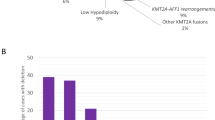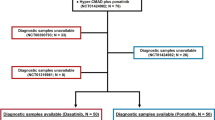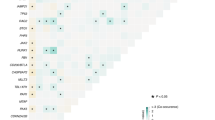Abstract
Despite the favorable prognosis of childhood acute lymphoblastic leukemia (ALL), a substantial subset of patients relapses. As this occurs not only in the high risk but also in the standard/intermediate groups, the presently used risk stratification is suboptimal. The underlying mechanisms for treatment failure include the presence of genetic changes causing insensitivity to the therapy administered. To identify relapse-associated aberrations, we performed single-nucleotide polymorphism array analyses of 307 uniformly treated, consecutive pediatric ALL cases accrued during 1992–2011. Recurrent aberrations of 14 genes in patients who subsequently relapsed or had induction failure were detected. Of these, deletions/uniparental isodisomies of ADD3, ATP10A, EBF1, IKZF1, PAN3, RAG1, SPRED1 and TBL1XR1 were significantly more common in B-cell precursor ALL patients who relapsed compared with those remaining in complete remission. In univariate analyses, age (⩾10 years), white blood cell counts (>100 × 109/l), t(9;22)(q34;q11), MLL rearrangements, near-haploidy and deletions of ATP10A, IKZF1, SPRED1 and the pseudoautosomal 1 regions on Xp/Yp were significantly associated with decreased 10-year event-free survival, with IKZF1 abnormalities being an independent risk factor in multivariate analysis irrespective of the risk group. Older age and deletions of IKZF1 and SPRED1 were also associated with poor overall survival. Thus, analyses of these genes provide clinically important information.
This is a preview of subscription content, access via your institution
Access options
Subscribe to this journal
Receive 12 print issues and online access
$259.00 per year
only $21.58 per issue
Buy this article
- Purchase on Springer Link
- Instant access to full article PDF
Prices may be subject to local taxes which are calculated during checkout



Similar content being viewed by others
References
Pui CH, Relling MV, Downing JR . Acute lymphoblastic leukemia. N Engl J Med 2004; 350: 1535–1548.
Schmiegelow K, Forestier E, Hellebostad M, Heyman M, Kristinsson J, Söderhäll S et al. Long-term results of NOPHO ALL-92 and ALL-2000 studies of childhood acute lymphoblastic leukaemia. Leukemia 2010; 24: 345–354.
Einsiedel HG, von Stackelberg A, Hartmann R, Fengler R, Schrappe M, Janka-Schaub G et al. Long-term outcome in children with relapsed ALL by risk-stratified salvage therapy: results of trial acute lymphoblastic leukemia-relapse study of the Berlin-Frankfurt-Münster Group 87. J Clin Oncol 2005; 23: 7942–7950.
Mullighan CG, Phillips LA, Xiaoping S, Ma J, Miller CB, Shurtleff SA et al. Genomic analysis of the clonal origins of relapsed acute lymphoblastic leukemia. Science 2008; 322: 1377–1380.
Malempati S, Gaynon PS, Sather H, La MK, Stork LC . Outcome after relapse among children with standard-risk acute lymphoblastic leukemia: Children’s Oncology Group study CCG-1952. J Clin Oncol 2007; 25: 5800–5807.
Schultz KR, Pullen DJ, Sather HN, Shuster JJ, Devidas M, Borowitz MJ et al. Risk- and response-based classification of childhood B-precursor acute lymphoblastic leukemia: a combined analysis of prognostic markers from the Pediatric Oncology Group (POG) and Children's Cancer Group (CCG). Blood 2007; 109: 926–935.
Shikano T, Ishikawa Y, Ohkawa M, Hatayama Y, Nakadate H, Hatae Y et al. Karyotypic changes from initial diagnosis to relapse in childhood acute leukemia. Leukemia 1990; 4: 419–422.
Heerema NA, Palmer CG, Weetman R, Bertolone S . Cytogenetic analysis in relapse childhood acute lymphoblastic leukemia. Leukemia 1992; 6: 185–192.
Choi S, Henderson MJ, Kwan E, Beesley AH, Sutton R, Bahar AY et al. Relapse in children with acute lymphoblastic leukemia involving selection of a preexisting drug-resistant subclone. Blood 2007; 110: 632–639.
Henderson MJ, Choi S, Beesley AH, Sutton R, Venn NC, Marshall GM et al. Mechanism of relapse in pediatric acute lymphoblastic leukemia. Cell Cycle 2008; 7: 1315–1320.
Peham M, Konrad M, Harbott J, König M, Haas OA, Panzer-Grümayer ER . Clonal variation of the immunogenotype in relapsed ETV6/RUNX1-positive acute lymphoblastic leukemia indicates subclone formation during early stages of leukemia development. Genes Chromosomes Cancer 2004; 39: 156–160.
Zuna J, Ford AM, Peham M, Patel N, Saha V, Eckert C et al. TEL deletion analysis supports a novel view of relapse in childhood acute lymphoblastic leukemia. Clin Cancer Res 2004; 10: 5355–5360.
Yang JJ, Bhojwani D, Yang W, Cai X, Stocco G, Crews K et al. Genome-wide copy number profiling reveals molecular evolution from diagnosis to relapse in childhood acute lymphoblastic leukemia. Blood 2008; 112: 4178–4183.
Kawamata N, Ogawa S, Seeger K, Kirschner-Schwabe R, Huynh T, Chen J et al. Molecular allelokaryotyping of relapsed pediatric acute lymphoblastic leukemia. Int J oncol 2009; 34: 1603–1612.
Tosello V, Mansour MR, Barnes K, Paganin M, Sulis ML, Jenkinson S et al. WT1 mutations in T-ALL. Blood 2009; 114: 1038–1045.
Davidsson J, Paulsson K, Lindgren D, Lilljebjörn H, Chaplin T, Forestier E et al. Relapsed childhood high hyperdiploid acute lymphoblastic leukemia: presence of preleukemic ancestral clones and the secondary nature of microdeletions and RTK-RAS mutations. Leukemia 2010; 24: 924–931.
van Delft FW, Horsley S, Colman S, Anderson K, Bateman C, Kempski H et al. Clonal origins of relapse in ETV6-RUNX1 acute lymphoblastic leukemia. Blood 2011; 117: 6247–6254.
Kuiper RP, Waanders E, van der Velden VHJ, van Reijmersdal SV, Venkatachalam R, Scheijen B et al. IKZF1 deletions predict relapse in uniformly treated pediatric precursor B-ALL. Leukemia 2010; 24: 1258–1264.
Zhang J, Mullighan CG, Harvey RC, Wu G, Chen X, Edmonson M et al. Key pathways are frequently mutated in high-risk childhood acute lymphoblastic leukemia: a report from the Children’s Oncology Group. Blood 2011; 118: 3080–3087.
Waanders E, van der Velden VHJ, van der Schoot CE, van Leeuwen FN, van Reijmersdal SV, de Haas V et al. Integrated use of minimal residual disease classification and IKZF1 alteration status accurately predict 79% of relapses in pediatric acute lymphoblastic leukemia. Leukemia 2011; 25: 254–258.
Mullighan CG, Xiaoping S, Zhang J, Radtke I, Phillips LA, Miller CB et al. Deletion of IKZF1 and prognosis in acute lymphoblastic leukemia. N Engl J Med 2009; 360: 470–480.
Brems H, Chmara M, Sahbatou M, Denayer E, Taniguchi K, Kato R et al. Germline loss-of-function mutations in SPRED1 cause a neurofibromatosis 1-like phenotype. Nat Genet 2007; 39: 1120–1126.
Pasmant E, Ballerini P, Lapillonne H, Perot C, Vidaud D, Leverger G et al. SPRED1 disorder and predisposition to leukemia in children. Blood 2009; 114: 1131.
Case M, Matheson E, Minto L, Hassan R, Harrison CJ, Bown N et al. Mutation of genes affecting the RAS pathway is common in childhood acute lymphoblastic leukemia. Cancer Res 2008; 68: 6803–6809.
Vignali M, Workman JL . Location and function of linker histones. Nat Struct Biol 1998; 5: 1025–1028.
Loudin MG, Wang J, Esastwood Leung H-C, Gurusiddappa S, Meyer J, Condos G et al. Genomic profiling in Down syndrome acute lymphoblastic leukemia identifies histone gene deletions associated with altered methylation profiles. Leukemia 2011; 25: 1555–1563.
Mullighan CG, Goorha S, Radtke I, Miller CB, Coustan-Smith E, Dalton JD et al. Genome-wide analysis of genetic alterations in acute lymphoblastic leukaemia. Nature 2007; 446: 758–764.
Zhang Y, Chen A, Yan XM, Huang G . Disordered epigenetic regulation in MLL-related leukemia. Int J Hematol 2012; 96: 428–437.
Starkova J, Zamostna B, Mejstrikova E, Krejci R, Drabkin HA, Trka J . HOX gene expression in phenotypic and genotypic subgroups and low HOXA gene expression as an adverse prognostic factor in pediatric ALL. Pediatr Blood Cancer 2010; 55: 1072–1082.
Yan XJ, Xu J, Gu ZH, Pan CM, Lu G, Shen Y et al. Exome sequencing identifies somatic mutations of DNA methyltransferase gene DNMT3A in acute monocytic leukemia. Nat Genet 2011; 43: 309–315.
Chung YR, Schatoff E, Abdel-Wahab O . Epigenetic alterations in hematopoietic malignancies. Int J Hematol 2012; 96: 413–427.
Parker H, An Q, Barber K, Case M, Davies T, Konn Z et al. The complex genomic profile of ETV6-RUNX1 positive acute lymphoblastic leukemia highlights a recurrent deletion of TBL1XR1. Genes Chromosomes Cancer 2008; 47: 1118–1125.
Hauer J, Mullighan CG, Morillon E, Wang G, Bruneau J, Brousse N et al. Loss of p19Arf in a Rag1(−/−) B-cell precursor population initiates acute B-lymphoblastic leukemia. Blood 2011; 118: 544–553.
Yenerel MN, Sundell IB, Weese J, Bulger M, Gilligan DM . Expression of adducin genes during erythropoiesis: a novel erythroid promoter for ADD2. Exp Hematol 2005; 33: 758–766.
Halleck MS, Lawler JF JR, Blackshaw S, Gao L, Nagarajan P, Hacker C et al. Differential expression of putative transbilayer amphipath transporters. Physiol Genomics 1999; 1: 139–150.
Brown CE, Tarun SZ Jr, Boeck R, Sachs AB . PAN3 encodes a subunit of the Pab1p-dependent poly(A) nuclease in Saccharomyces cerevisiae. Mol Cell Biol 1996; 16: 5744–5753.
Lahortiga I, Vizmanos JL, Agirre X, Vázquez I, Cigudosa JC, Larrayoz MJ et al. NUP98 is fused to adducin 3 in a patient with T-cell acute lymphoblastic leukemia and myeloid markers, with a new translocation t(10;11)(q25;p15). Cancer Res 2003; 63: 3079–3083.
Harvey RC, Mullighan CG, Wang X, Dobbin KK, Davidson GS, Bedrick EJ et al. Identification of novel cluster groups in pediatric high-risk B-precursor acute lymphoblastic leukemia with gene expression profiling: correlation with genome-wide DNA copy number alterations, clinical characteristics and outcome. Blood 2010; 116: 4874–4884.
Paulsson K, Forestier E, Lilljebjörn H, Heldrup J, Behrendtz M, Young BD et al. Genetic landscape of high hyperdiploid childhood acute lymphoblastic leukemia. Proc Natl Acad Sci USA 2010; 107: 21719–21724.
Irving JA, Minto L, Bailey S, Hall AG . Loss of heterozygosity and somatic mutations of the glucocorticoid receptor gene are rarely found at relapse in pediatric acute lymphoblastic leukemia but may occur in a subpopulation early in the disease course. Cancer Res 2005; 65: 9712–9718.
Prevot D, Voeltzel T, Birot AM, Morel AP, Rostan MC, Magaud JP et al. The leukemia-associated protein Btg1 and the p53-regulated protein Btg2 interact with the homeoprotein Hoxb9 and enhance its transcriptional activation. J Biol Chem 2000; 275: 147–153.
Waanders E, Scheijen B, van der Meer LT, van Reijmersdal SV, van Emst L, Kroeze Y et al. The origin and nature of tightly clustered BTG1 deletions in precursor B-cell acute lymphoblastic leukemia support a model of multiclonal evolution. PLoS Genet 2012; 8: e1002533.
van Galen JC, Kuiper RP, van Emst L, Levers M, Tijchon E, Scheijen B et al. BTG1 regulates glucocorticoid receptor autoinduction in acute lymphoblastic leukemia. Blood 2010; 115: 4810–4819.
Tissing WJ, Meijerink JP, Brinkhof B, Broekhuis MJ, Menezes RX, den Boer ML et al. Glococorticoid-induced glucocorticoid-receptor expression and promoter usage is not linked to glucocorticoid resistance in childhood ALL. Blood 2006; 108: 1045–1049.
Ballerini P, Landman-Parker J, Cayuela JM, Asnafi V, Labopin M, Gandemer V et al. Impact of genotype on survival of children with T-cell acute lymphoblastic leukemia treated according to the French protocol FRALLE-93: the effect of TLX3/HOX11L2 gene expression on outcome. Haematologica 2008; 93: 1658–1665.
Busslinger M . Transcriptional control of early B cell development. Annu Rev Immunol 2004; 22: 55–79.
Georgopoulos K, Bigby M, Wang JH, Molnar A, Wu P, Winandy S et al. The Ikaros gene is required for the development of all lymphoid lineages. Cell 1994; 79: 143–156.
Martinelli G, Iacobucci I, Storlazzi CT, Vignetti M, Paoloni F, Cilloni D et al. IKZF1 (Ikaros) deletions in BCR-ABL1-positive acute lymphoblastic leukemia are associated with short disease-free survival and high rate of cumulative incidence of relapse: a GIMEMA AL WP report. J Clin Oncol 2009; 27: 5202–5207.
Mullighan CG, Collins-Underwood JR, Phillips LAA, Loudin MG, Liu W, Zhang J et al. Rearrangement of CRLF2 in B-progenitor- and Down syndrome-associated acute lymphoblastic leukemia. Nat Genet 2009; 41: 1243–1246.
Chen IM, Harvey RC, Mullighan CG, Gastier-Foster J, Wharton W, Kang H et al. Outcome modeling with CRLF2, IKZF1, JAK, and minimal residual disease in pediatric acute lymphoblastic leukemia: a Children's Oncology Group study. Blood 2012; 119: 3512–3522.
Öfverholm I, Tran AN, Heyman M, Zachariadis V, Nordenskjöld M, Nordgren A et al. Impact of IKZF1 deletions and PAX5 amplifications in pediatric B-cell precursor ALL treated according to NOPHO protocols. Leukemia 2013; 27: 1936–1939.
Acknowledgements
This study was supported by grants from the Swedish Cancer Society, the Swedish Childhood Cancer Foundation, the Crafoord foundation and the Swedish Research Council.
Author information
Authors and Affiliations
Corresponding author
Ethics declarations
Competing interests
The authors declare no conflict of interest.
Additional information
Supplementary Information accompanies this paper on the Leukemia website
Supplementary information
Rights and permissions
About this article
Cite this article
Olsson, L., Castor, A., Behrendtz, M. et al. Deletions of IKZF1 and SPRED1 are associated with poor prognosis in a population-based series of pediatric B-cell precursor acute lymphoblastic leukemia diagnosed between 1992 and 2011. Leukemia 28, 302–310 (2014). https://doi.org/10.1038/leu.2013.206
Received:
Revised:
Accepted:
Published:
Issue Date:
DOI: https://doi.org/10.1038/leu.2013.206



